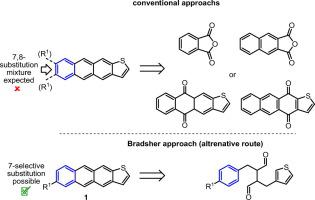Tetrahedron Letters ( IF 1.5 ) Pub Date : 2022-11-19 , DOI: 10.1016/j.tetlet.2022.154258 Mustafa A-jabbar Al-Jumaili , Mohammed Adnan Abid

|
Anthracenes and their heteroatom derivatives are of high interest in recent years because of their unique properties for biological, photophysical, and photochemical applications. Nowadays, these are many and include biological sensors and their use in solar cells, OFETs, OLEDs and many other organic materials applications. In this review we highlight recent methodologies for the synthesis of anthra[2,3-b]thiophene 1 and naphtho[2,3-b:6,7-b']dithiophene 2 using many of the best available different methods.
The main challenge in preparing these materials is the cost of the required starting materials. However, some significant developments in overcoming this limitation have been described in the last few years. In this review, we focus on mono and dithiophene acene cores for organic semiconductor materials that have attracted attention in recent decades.
中文翻译:

综述:用于有机半导体材料的蒽[2,3-b]噻吩和萘并[2,3-b:6,7-b']二噻吩片段的合成方法
近年来,蒽及其杂原子衍生物因其在生物、光物理和光化学应用中的独特性质而备受关注。如今,这些应用很多,包括生物传感器及其在太阳能电池、OFET、OLED 和许多其他有机材料应用中的应用。在这篇综述中,我们重点介绍了使用许多最佳可用不同方法合成蒽[2,3- b ]噻吩1和萘并[2,3- b :6,7- b' ]二噻吩2的最新方法。
制备这些材料的主要挑战是所需起始材料的成本。然而,在过去几年中已经描述了克服这种限制的一些重要发展。在这篇综述中,我们重点关注了近几十年来备受关注的有机半导体材料的单和二噻吩并苯核。






























 京公网安备 11010802027423号
京公网安备 11010802027423号